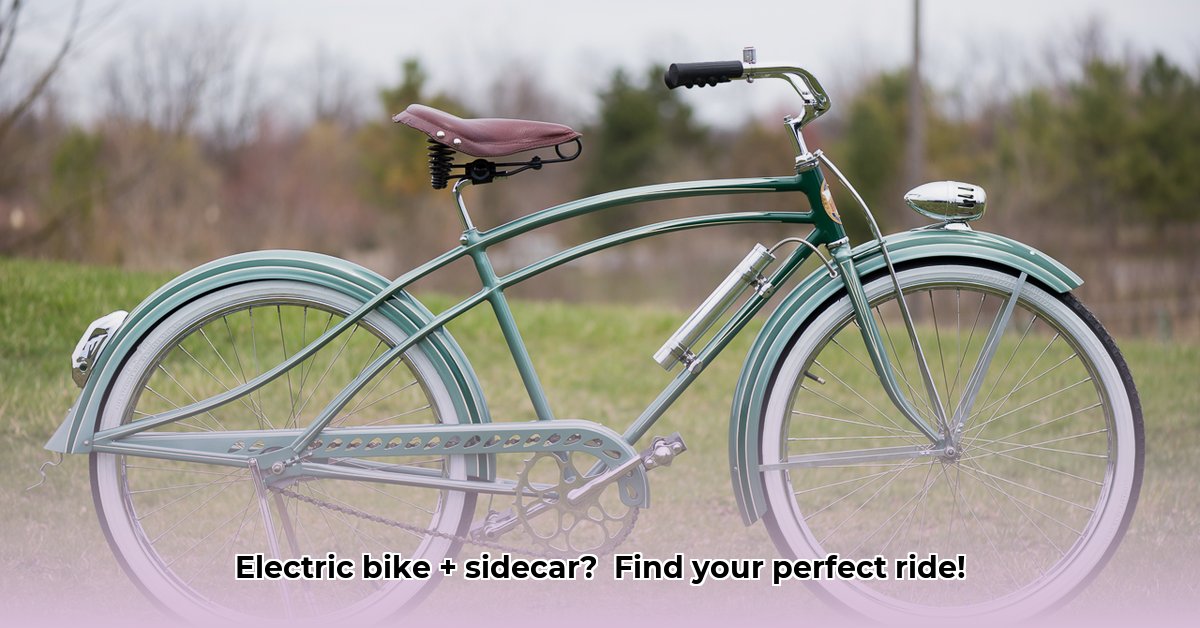Want an electric bike that’s also a cargo hauler, eye-catching, and eco-friendly? Electric bikes with detachable sidecars might be the perfect choice! However, selecting the right one requires careful consideration. This guide helps you navigate the world of e-bikes and sidecars, covering safety, ease of sidecar attachment/detachment, finding the best model for your budget and lifestyle, and legal considerations. We’ll explore crucial components, top-rated models, comparing pros and cons, and offer tips for safe riding and maintenance. Whether you’re budget-conscious, need safe handling advice, or seek the latest models, this guide will help you find the perfect electric bike with a detachable sidecar. Let’s begin!
Electric Bicycle with Sidecar: Your 2024 Buyer’s Guide
Choosing an electric bike with a detachable sidecar is an excellent choice if you need extra cargo space, a unique ride, or have accessibility needs! But it’s a decision that demands careful thought. This guide will help you navigate the exciting world of these awesome two-wheelers, making those long rides a breeze.
Understanding Sidecar E-Bikes: More Than Just a Trend
Electric bikes with sidecars, sometimes called “sidecar e-bikes,” combine the efficiency of electric propulsion with the added utility of a sidecar. This configuration offers several advantages:
- Increased carrying capacity: Transport groceries, pets, children, or equipment with ease.
- Enhanced stability: The third wheel provides improved balance, especially at low speeds or when carrying heavy loads.
- Unique style: Stand out from the crowd with a distinctive and eye-catching ride.
- Accessibility: Sidecars can offer mobility solutions for individuals with balance or stability challenges.
However, sidecar e-bikes also present challenges:
- Handling: Requires practice and adaptation due to altered weight distribution and turning dynamics.
- Size and storage: The added width and length make maneuvering in tight spaces and storage more difficult.
- Cost: Sidecar e-bikes are typically more expensive than standard e-bikes.
Key Features to Consider When Choosing Your Electric Bike with Sidecar
Before you’re drawn in by a shiny new model, let’s discuss the essentials. These features will significantly impact your overall experience, safety, and the long-term use of your sidecar e-bike.
1. Sidecar Attachment and Detachment: How easily can you attach and detach the sidecar? A good system should be quick, secure, and hassle-free. You don’t want to spend thirty minutes struggling with it every time you want to use it! Look for smooth, easy-to-use mechanisms that ensure sidecar stability. Consider the tools required, the weight of the sidecar itself, and the overall simplicity of the process. Some systems utilize quick-release levers, while others require wrenches and more involved alignment.
2. Weight Capacity: How much are you planning to haul? Groceries? Camping gear? A small child? A small adult? The sidecar’s size and construction directly affect how much weight it can handle safely. Check both the sidecar’s maximum payload capacity and the e-bike’s overall weight limit. Don’t overload it – safety always comes first, and this will prevent electric bike accidents.
3. Safety First! Brakes, Lights, and Restraints: This isn’t just about following rules; it’s about your well-being and your passenger’s. Ensure the brakes are powerful and responsive, especially with the extra weight. Hydraulic disc brakes are generally recommended. Bright lights are crucial for visibility in low-light conditions. Look for integrated headlights, taillights, and ideally, turn signals. If you’re carrying a passenger, ensure adequate restraints, such as seatbelts or harnesses, to keep them safe, which is key for electric bike safety gear. D-rings for securing pet carriers or cargo are also a plus.
4. Motor Power, Battery Life, and Range: The motor’s power impacts how easily your bike handles the added weight of the sidecar, especially on inclines. A more powerful motor (750W or higher) will likely provide better performance. Battery life is directly linked to how far you can go on a single charge. The range may decrease significantly when hauling a sidecar, so choose based on your needs. Consider how often you’ll need to recharge and understand e-bike battery maintenance. Look for battery capacity of at least 500Wh for a reasonable range.
5. Build Quality and Materials: You’re making an investment, so you want it to last. Look for a bike and sidecar constructed from durable, high-quality materials. Sturdy construction will withstand the bumps and knocks of everyday use, and you can consider electric bike customization. Steel or aluminum frames are common choices. Consider the quality of the sidecar’s suspension, seating materials, and weather resistance.
6. Comfort and Ergonomics (For You AND Your Passenger!): A comfortable ride is a happy ride. Think about the seating position for both you and any passenger. Is there enough legroom and headroom in the sidecar? A well-designed sidecar will make your rides more enjoyable and consider proper electric bike seat. Adjustable seats, suspension systems, and ergonomic handlebars can enhance comfort.
7. Wheel Size and Tires: Wider tires (3″ or more) provide better stability and traction, especially on uneven surfaces. Consider the wheel size of both the e-bike and the sidecar. Smaller wheels may be more nimble, while larger wheels offer a smoother ride.
Top Models: Features to Consider
It is best to do your research on current market offerings from reputable sources. However, when you’re comparing bikes, here’s what to look for when considering electric bike maintenance:
- Ease of Use: How easy is it to attach and detach the sidecar? How simple are the controls? Does it feel intuitive?
- Performance: How does it handle the extra weight uphill? How quickly does it accelerate? What’s the top speed with and without the sidecar?
- Comfort: Is it comfortable for both the rider and passenger (if applicable)? Does the sidecar feel stable? Is there sufficient padding and support?
- Handling: How does the bike handle in turns? Is it easy to maintain balance? Does the sidecar lift off the ground during sharp turns?
- Components: What is the quality of the brakes, gears, and other components? Are they appropriate for the weight and speed of the e-bike with a sidecar?
Buying Tips and Considerations for Your Electric Bike with Sidecar
1. Budget Wisely: These bikes aren’t cheap, so set a realistic budget before you start browsing with electric bike financing. Explore financing options if needed. Remember to factor in the cost of accessories, maintenance, and insurance.
2. Intended Use: How will you primarily use your bike-and-sidecar combo? Daily commutes? Weekend adventures? Transporting children or pets? This will influence your choice of motor power, battery capacity, and overall style for your electric bike accessories.
3. Safety Precautions: Practice riding with the sidecar attached in a safe, open area before hitting busy roads. Regular maintenance is key to keeping your bike in top shape and preventing accidents. Always wear a helmet and consider adding electric bike lights. Ensure your passenger also wears a helmet.
4. Legal and Regulatory Aspects: Check your local laws and regulations regarding electric bikes with sidecars. Some areas may have specific rules about speed limits, registration, or licensing to know more about electric bike laws. Some jurisdictions may classify sidecar e-bikes differently than standard e-bikes.
Addressing Concerns: Safety and Handling
Handling a bike with a sidecar attached is noticeably different from riding a standard electric bike. The added weight and altered center of gravity change how it steers, especially during turns. You’ll need to practice and adjust your riding style. Expect slower speeds and wider turns, particularly when navigating corners and consider electric bike training. Start in a large, open space and gradually increase your speed and complexity of maneuvers.
Regarding safety, ensuring your bike has bright lights, reliable brakes, and proper restraints in the sidecar if you plan to carry passengers is crucial. Regular maintenance checks are essential to ensure everything is functioning correctly so always have an electric bike repair stand. Pay close attention to tire pressure, brake pad wear, and cable tension.
Sidecar Specifics: Choosing the Right One
If you’re considering adding a sidecar to an existing e-bike, ensure it’s compatible. Factors to consider include:
- E-bike frame compatibility: Not all e-bikes are designed to accommodate a sidecar attachment.
- Motor power: Ensure your e-bike’s motor is powerful enough to handle the added weight and drag.
- Braking system: Upgrade your brakes if necessary to ensure sufficient stopping power.
- Sidecar weight and dimensions: Choose a sidecar that is appropriately sized and weighted for your e-bike and intended use.
Final Thoughts: Making the Right Choice
An electric bike with a detachable sidecar offers versatility and style. However, it presents unique challenges regarding handling and cost. Thorough research, consideration of your needs, and a commitment to safe riding practices are essential for a positive experience. Remember, safety always comes first! Happy riding considering your electric bike insurance!
How to Safely Operate an Electric
- Fun Facts About Hydroelectric Energy You Might Not Know - January 7, 2026
- Fun Facts About Hydropower And How Water Makes Electricity - January 6, 2026
- Hydro Power Everyday Keeps Lights On and Water Flowing - January 5, 2026
















